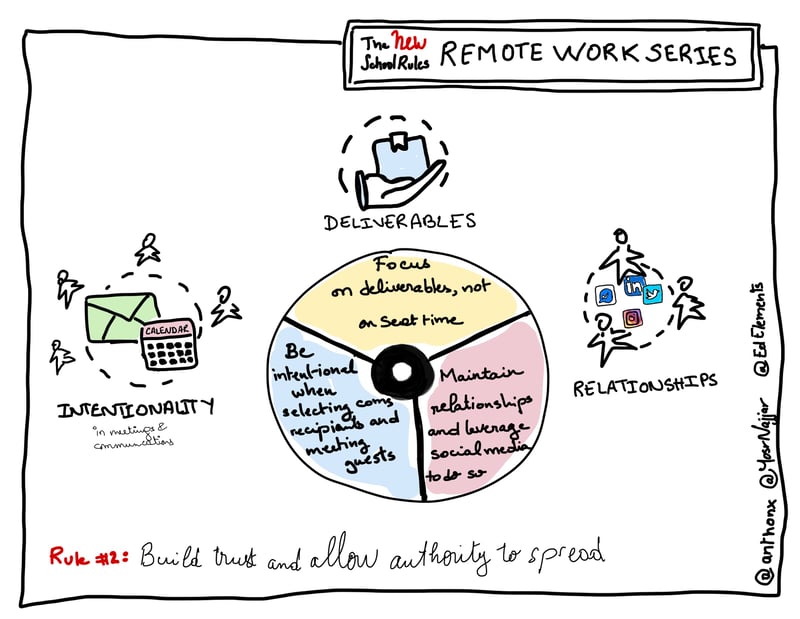
The Remote Work Series: Build Trust and Allow Authority to Spread
Organizational Leadership & Change Management | Remote Work
Working with colleagues in-person may provide more many opportunities to build trust with your team, but it isn’t impossible in a virtual environment. Even though you’re unable to walk over to a colleague’s desk to ask a quick question, you have an opportunity to reflect on how you can tap into existing relationships and build new ones, even through a screen.

Virtual Collaboration Can Flatten Hierarchy
When working in an office building, it’s easy to rely on the same people for support. However, there are many benefits to virtual collaboration that we should take advantage of. For example, during a company-wide zoom call, there is no clear, visible hierarchy with one individual at the head of the table. Your organization may also not require a strict dress code. Both can make team members feel more comfortable with sharing ideas without the feeling of intimidation or pressure. An environment that is psychologically safe for all members of a team can allow trust to grow organically.
Overcoming the Challenges to Building Trust Virtually
Given that we aren’t bumping into our colleagues in the hallway and checking in on how they’re doing, we need to be more intentional about how we reach out and schedule meetings. It’s important to understand how a colleague can support you by meeting, and how much of their time you will need.
Equally important is punctuality. Waiting 5 minutes for an in-person meeting to start might not feel as long a time as waiting for a colleague to join a Zoom call. That may be because it’s easier to close the Zoom app than it is to walk back to your desk. After you’ve spent some time considering why you wanted to set a meeting, showing up on time demonstrates that you appreciate your colleague’s time.
Missed the previous post? Check out Part 2 in the Remote Work Series:
Ways to Build Trust on Your Team
Building trust on your team is about finding multiple ways you can put “deposits” into your relationships. There are many simple ways you can do this, and I’d like to show you a few ideas I’ve used with my company.
-
Use social media to engage with your teammates online. You can like, re-share, and reply to posts that congratulate their work, and share appreciation for the information they share.
-
Leave open spaces on your calendar for informal check-ins with teammates. Be sure to let them know that you’ve left those spaces open so that they can find times to touch base. You can also model this by asking a colleague if you can block some time off to meet. This demonstrates an eagerness to connect beyond streams of work and can help to spread this practice throughout your organization.
-
Try to make your emails less formal. It’s easy to get formal in email when you’re trying to communicate a lot of information in a clear manner. However, doing so can come across as distant. Add inside jokes, funny pictures from previous meetings, and more to reduce pressure and make your communication style more inviting.
-
Adjust the way you think about productivity. We’ve been so indoctrinated about seat time and hours of work (our jobs are not always a typical 9-5, especially when working remotely). We need to shift to thinking more about deliverables. School systems are still tracking seat time as a measure of learning, whereas task completion might be a better indicator of learning.
With shelter-in-place scenarios and school closures, people are facing all kinds of distractions during their normal 9-5. There might be kids in the house, delivery people dropping off packages, partners working, dogs barking, and more. All of this makes allowing people to adjust their own schedules even more important. This kind of flexibility is needed when the line between work and home is being blurred. Allowing authority to spread will help to foster an environment where trust is among the least of your team’s worries.
Subscribe to my YouTube channel to check out the rest of the series, and for more videos about learning organizations, team habits, and leadership.
Looking for the next post in the Remote Work Series?
Check out: Define the Work Before the People
About Anthony Kim
Anthony Kim is a Corwin Press bestselling author, with publications including The New Team Habits, The New School Rules, and The Personalized Learning Playbook. His writing ranges the topics of the future of work, leadership and team motivation, improving the way we work, and innovation in systems-based approaches to organizations and school design. Anthony believes that how we work is the key determinant to the success of any organization. He is a nationally recognized speaker on learning and his work has been referenced by the Christensen Institute, iNACOL, EdSurge, CompetencyWorks, Education Week, District Administration, and numerous research reports. In addition to his writing, Anthony is the founder and Chief Learning Officer of Education Elements, a trusted partner and consultant to over 1,000 schools nationwide. Anthony has been the founder of several companies across multiple industries, including online education, ecommerce, and concerts and events.



